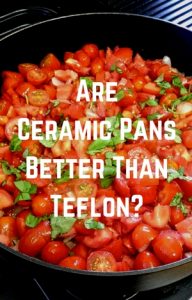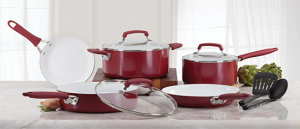 Are you tired of scraping stuck-on food from your pans and thinking how lovely a set of non-stick cookware would be, but not sure what type to purchase? First of all, you should know there are basically only two choices — you’ll either decide on ceramic or a PTFE, (a man-made chemical otherwise known as Teflon) based product. More on PTFE below. For many decades, the only option to purchase a non-stick cookware set was one coated with a finish called Teflon, by the DuPont company. In the past few years though, there’s been quite a bit of publicity about the safety of PTFE, in that the pans can emit highly toxic fumes when overheated. These fumes have proven harmful to not only humans, but to birds. With that said, it’s good for you to know that these pans are available from many different brands, although some are upfront with what the finish is made from, and some are not.
Are you tired of scraping stuck-on food from your pans and thinking how lovely a set of non-stick cookware would be, but not sure what type to purchase? First of all, you should know there are basically only two choices — you’ll either decide on ceramic or a PTFE, (a man-made chemical otherwise known as Teflon) based product. More on PTFE below. For many decades, the only option to purchase a non-stick cookware set was one coated with a finish called Teflon, by the DuPont company. In the past few years though, there’s been quite a bit of publicity about the safety of PTFE, in that the pans can emit highly toxic fumes when overheated. These fumes have proven harmful to not only humans, but to birds. With that said, it’s good for you to know that these pans are available from many different brands, although some are upfront with what the finish is made from, and some are not.
In light of these findings, another alternative using a ceramic based finish has come on the scene. Below is an overview of the two.
Teflon Cookware
I’ll start with a little background of Teflon. PTFE, short for polytetrafluoroethylene (what a mouthful!) is also known as Teflon, as mentioned above. This substance is what makes different materials and finishes non-stick. A man by the name of Roy Plunkett discovered this substance in 1938 while working at the DuPont Company. While Teflon has been around since this time, it’s been used on other materials, but not on cookware until the 1950’s, when a man by the name of Marc Gregoire began to experiment and apply it to some cooking pans. It became wildly popular and a top choice in cookware for many years.
It wasn’t until recently that studies have shown that the PTFE, when used in higher temperatures than recommended runs the risk of releasing toxic chemicals and gases into the environment, as well as the food.This was found to cause sickness and in some cases lead to cancer in humans. It was also discovered that the toxic fumes are also extremely harmful to birds. Even a small amount of the fumes can kill birds; both indoor pet birds during cooking, as well as outdoor wild birds when the pans are dumped in the garbage and melted down.
Some brands, including DuPont are now trying to counter the issue of the hazards of PTFE by downplaying its use (some brands don’t even mention PTFE) and the toxicity. If used at recommended temperatures, the Teflon is safe, provided the surface is not scratched. However, the surface can scratch quite easily, and overheating can occur. But to the manufacturers’ credit, they’re also refining their methods of applying the PTFE to make the pans more resistant against high temperatures and scratching.
Ceramic Coated Cookware
Because of all this noise about PTFE, manufactures have come up with an alternative to Teflon—ceramic coating. This is now considered to be the safer option and has become quite popular in recent years. Ceramic is free of PTFE as well as PFOA (another man-made chemical found in regular nonstick pans). There are a wide variety of finishes based on either silicone or silicon ceramics technologies, depending on the brand. For instance, Cuisinart uses a coating based on silicon which they have branded, Ceramica©. Thermolon is another coating made from silicon and oxygen. These formulations of coatings are poured over the metal pan base and are then sealed with a protective finish. These coatings are healthy, safe, and resistant to scratching.
Here are some benefits of ceramic coated pans:
- Will not leach chemicals into food or the environment
- More scratch resistant than Teflon
- Lots of different styles and colors available
- Very easy to clean
- Cooks more evenly
- Perform as well if not better than Teflon
Some folks feel that ceramic surfaces wear much more quickly than Teflon. It’s true that you do have to ‘baby’ the surface and take care to follow the manufacturer instructions. Especially important is to not cook at high temperatures because the higher temps cause the coating to turn sticky and break down the materials, eventually damaging the surface. Food still cooks well at lower temps because of the excellent heat conductivity of the pans.
These coatings are now considered to be a safer alternative and are preferred more by consumers than traditional non-stick coatings. Typically, the lifespan of these silicon based coatings are 3-4 years; perhaps a little shorter than Teflon. But, because the coatings are a relatively new technology, manufacturers are continually improving the process and quality. They’re adding more layers to the coating, and experimenting with more ways to make it more durable with longer life spans.
Bottom line is, if you’re questioning which to purchase, here’s my take: ceramic is an affordable and safe, toxic-free choice, they’re attractive with so many different color combinations and require fairly low-maintenance. Simply don’t overheat, use nylon, silicone, or bamboo utensils that won’t scratch the surface, and follow any other manufacturer specific instructions. By doing this, you’ll enjoy cooking with your pans and they should last 3-4 years or longer.
